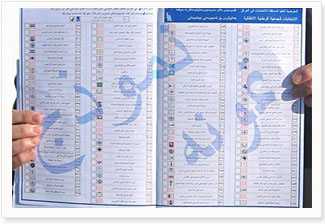Archived Items

A ballot to be used in the January 30th Iraqi elections is displayed Jan. 19, 2005. State Department Photo.
- Iraq's January 30 election marked an important step on the road to a secure, prosperous, and democratic Iraq.
- The Iraqis sought to hold elections that: (1) were free, credible, and legitimate; (2) advanced the development of a constitution that embraces the freedoms and principles of democratic systems of government; and (3) resulted in a representative government committed to peace, stability, and democracy in Iraq and throughout the region.
- When the votes are counted, the Iraqi people will have elected a 275-member Transitional National Assembly. The Assembly will:
- Serve as Iraq's national legislature.
- Name a Presidency Council, consisting of a President and two Vice Presidents. (By unanimous agreement, the Presidency Council will appoint a Prime Minister and, on his recommendation, cabinet ministers.)
- Draft Iraq's new constitution, which will be presented to the Iraqi people for their approval in a national referendum in October 2005. Under the new constitution, Iraq will elect a permanent government in December 2005.
- The Iraqi people suffered greatly during the more than three decades of Ba'athist tyranny. They are no strangers to violence and intimidation. So despite threats of violence, Iraqis sought to shape their future by exercising their right to vote.
- Successful elections in Iraq are a blow to the forces of terror. In time, the defeat of terror in Iraq will set that nation on a course to lasting freedom, and will give hope to millions. And ultimately, a free, democratic Iraq will inspire reformers throughout the Middle East and make America more secure.
- A goal of Iraq's Transitional Administrative Law (the law governing Iraq during its transition to a constitutional democracy) is a Transitional National Assembly composed of at least 25 percent women.
- For the election, a voter-registration list of 14.3 million names was compiled. The voter-registration process consisted of validating and adding names or correcting information on the provisional voter-registration list, which was based on the food-ration public distribution system. Iraqis completed this process in six weeks.
- More than 500 voter registration centers were established to help Iraqis verify their registration. On election day, Iraqis voted at approximately 5,200 voting centers across Iraq.
- The Transitional National Assembly election was conducted according to a closed-list proportional-representation system with the entire country considered as a single electoral district.
- In addition to the election of a Transitional National Assembly, the Transitional Administrative Law calls for the election of provincial councils and a Kurdistan National Assembly. These provincial elections were also held on January 30.
- 111 political entities submitted candidate lists for the national elections, and a total of 256 political entities composed of 18,900 candidates registered to compete in the national election, 18 provincial elections, and the Kurdistan Regional government election. The 256 entities included 27 individuals, 33 coalitions of parties, and 196 independent parties, demonstrating widespread enthusiasm for the political process.
- The election was planned and executed by Iraqis for Iraqis. The United States and the international community have supported the Iraqi people's aspirations for freedom.
- The Independent Electoral Commission of Iraq was established to supervise the elections and ensure a fair and transparent process.
- The UN Electoral Assistance Division is advising the Independent Electoral Commission of Iraq. Other non-governmental organizations are providing technical support and assistance to the Independent Electoral Commission of Iraq and the Iraqi Interim Government until the entire electoral process is completed.
- The Independent Electoral Commission of Iraq and various non-governmental organizations conducted a voter-education campaign.
- The Independent Electoral Commission of Iraq has 150 staff at its national headquarters and 126 at governorate offices. For the election, it employed 120 trainers and more than 6,000 electoral workers at the Voter Registration Centers throughout Iraq.
- The role of the United States and the Coalition has been limited. The United States provided more than $40 million to help the Independent Electoral Commission of Iraq conduct elections. Japan pledged $40 million and the EU pledged $38 million for the election effort.
- International support for the Iraqi election has been essential. Military forces from 28 nations are working alongside Iraqi forces to help establish stability and security throughout Iraq. Coalition forces provided area security for polling day.
After the January 30, 2005 election:
- The votes will be tabulated and winners declared.
- The Transitional National Assembly will be seated.
- The Assembly will appoint a Presidency Council, consisting of a President and two Deputy Presidents.
- The Presidency Council will appoint a Prime Minister and--on his or her recommendation--cabinet ministers to run the Iraqi government's various ministries.
- The Prime Minister and his cabinet must receive a vote of confidence by a simple majority of the Transitional National Assembly before commencing work as a government.
- The Transitional National Assembly will draft a new Iraqi constitution.
- The draft constitution is to be presented to the Iraqi people for approval in a national referendum in October 2005.
By the end of 2005, the Iraqi people will elect a new national government under a new, permanent constitution.




